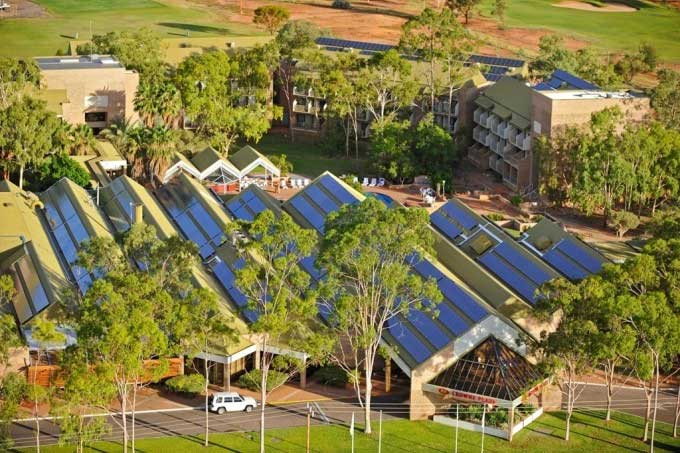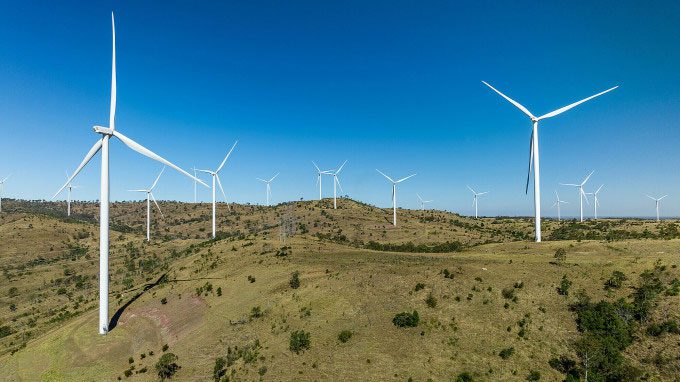The renewable energy sector in Australia is experiencing remarkable growth due to the combination of world-class technology, abundant natural resources, supportive policy mechanisms, and investment opportunities.
Australia possesses rich natural resources suitable for developing renewable energy, including high-intensity solar energy, wind resources, and a lengthy coastline with significant wave energy potential. Many leading renewable energy technologies have been developed in this country and are applied globally. Renewable energy accounted for 35.9% of Australia’s total electricity generation in 2022, an increase of 3.4% from the previous year. The Australian government aims to raise the share of renewable energy to 82% by 2030.

Port Augusta Renewable Energy Park – a combined solar and wind farm spanning 5,400 hectares in South Australia, featuring 50 turbines and 250,000 solar panels. (Photo: Austrade).
Solar Energy
Australia is the world’s largest producer of solar electricity, with 1.1 kW (1,166W) per capita, according to the Australian Photovoltaic Institute in 2022. One groundbreaking development that has contributed to the sustainable foundation of global green energy is the PERC solar cell, developed by Professor Martin Green and his research team; it has boosted energy conversion efficiency from 15% to 25%, performing well even in less favorable lighting conditions. Currently, PERC technology is used in over 90% of solar panels produced worldwide. This innovation has received numerous international awards and was recently honored at the VinFuture 2023.

More than 3 million Australian households (about 30%) have now installed rooftop solar panels. (Photo: Austrade).
Harnessing rooftop solar energy is a feasible and cost-effective solution that contributes to reducing global greenhouse gas emissions. Facing challenges in distributing electricity to apartment buildings, Allume Energy has revolutionized the way solar power is supplied to multiple apartments within the same building from a rooftop photovoltaic system. This SolShare technology has helped reduce carbon emissions by 28 tons annually for a typical apartment building and allows users to cut energy bills by 40%. This easy-to-install, manageable, and reasonably priced technology has been adopted in countries like Germany, the USA, and the UK. Allume Energy has sold over 350 systems worldwide, with an additional 10,000 units currently in production for market rollout.
Another promising initiative is ClearVue’s solar glass. With transparency up to 70% and a maximum output of 40 Watts per square meter, the product meets window glazing efficiency goals while providing some electrical power for the building.
Wind Energy
Offshore wind energy is emerging as a new sector in Australia. This field is well-suited to the vast spaces and strong coastal wind conditions near populated centers in the land of the kangaroo, especially with robust government support policies.
An Australian innovation to expedite the design process of wind farms is replacing traditional monitoring towers with SODAR systems that detect and classify sounds over the ocean. This mobile wind monitoring system from Fulcrum3D allows for three-dimensional wind speed measurements with an accuracy of up to 200 meters above ground, providing deeper insights into local wind characteristics, enabling faster and more accurate wind farm development.
Another technology, WindScape, is also improving wind farm development, provided by Windlab Systems. WindScape is a wind energy assessment and atmospheric modeling tool used by Windlab to effectively identify and develop wind farms with higher certainty and reduced risk, both in Australia and globally.

Coopers Gap – one of the largest wind farms in Australia, located in the Darling Downs region of Queensland. With 123 wind turbines, the land is also used for grazing livestock and other agricultural activities. (Photo: Austrade).
Corio Generation, a subsidiary of the Macquarie Group, is a world leader in offshore wind development. Corio is developing one of the first offshore wind projects in Victoria, Australia and has been actively operating in Vietnam since 2019.
With many impressive and effective innovations, wind energy accounted for 12.8% of Australia’s total electricity generation in 2022.
Hydrogen
Australia has become a pioneer in hydrogen by exporting the world’s first liquefied hydrogen shipment to Japan. In 2019, the Australian government announced the National Hydrogen Strategy, outlining a vision for a clean, innovative, safe, and competitive industry that aims to make Australia a “renewable energy superpower” globally by 2030.
Since the Australian government implemented this strategy, over 90 hydrogen projects have been announced across the country. Australia now boasts a system of world-leading hydrogen projects, making it one of the largest hydrogen exporters globally. Australia’s hydrogen, ammonia, and carbon recovery and storage projects have a potential investment value of AUD 185 billion.
The hydrogen industry in Australia is rapidly developing with advanced hydrogen production technologies being developed by various enterprises. Hazer Group is constructing a pilot plant using an exclusive process that employs iron ore as a catalyst to convert wastewater into hydrogen and graphite. Plasma pyrolysis technology expert SynergenMet is commercializing methane pyrolysis techniques to separate methane into hydrogen and carbon black. Sparc Technologies is developing a direct hydrogen production technology from water and sunlight without requiring electricity to power the electrolyzer.
The country is attracting investment from around the world. One such project is the Australia Renewable Energy Hub (AREH) 26GW in the Pilbara region of Western Australia. This combined solar and wind project is designed to produce green hydrogen on a scale of 6,500 km², nearly four times the area of London. Once completed, the project could produce 1.6 million tons of hydrogen annually and help reduce approximately 17 million tons of carbon emissions each year.
Another hydrogen plant, co-built by French energy company Engie and Japan’s Mitsui, is located in Western Australia, backed by a AUD 47.5 million grant from the Australian government. The first phase of the Yuri project is expected to be completed by 2024 and has the capacity to produce up to 640 tons of renewable hydrogen annually.
Biomass Energy
Biomass energy is another field where Australia is providing world-class technological solutions. These technologies range from producing high-quality biomass feedstocks to developing waste-to-energy projects.
In 2022, biomass electricity contributed 1.4% to Australia’s total electricity generation.
Australian companies with expertise in converting waste into energy include Utilitas, which has developed an anaerobic digestion process to generate renewable gas from organic waste; Renergi, which has developed pyrolysis technology for municipal solid waste; and Avertas Energy, which is developing a 36 MW waste-to-energy plant in Kwinana. Other Australian innovations in biomass energy include Licella’s technology that converts low-cost, inedible biomass waste into stable bio-crude oil that can be refined in traditional refineries.
Energy Storage
Energy storage is a crucial supporting technology for renewable energy, enhancing competitiveness and the penetration of renewable energy by coordinating energy supply on the grid, enabling distribution during peak times, peak load shedding, and allowing providers to manage supply and demand more effectively.
Australia has implemented some of the largest grid-connected lithium-ion solar batteries in the world, such as the Victorian Big Battery 300 MW/MWh. Pure pumped hydro is also set to debut in Australia with the Kidston 250 MW/2000 MWh project under construction, and feasibility studies are underway with Hydro Tasmania.

Neoen collaborates with Tesla and AusNet Services to implement the Victorian Big Battery project in Geelong – one of the largest energy storage projects in the world. (Photo: Victorian Big Battery).
The aforementioned groundbreaking achievements are the result of foresight, clear strategy, and strong investment from the government. Additionally, the support from policy and legal frameworks has enabled Australia to host many highly skilled and experienced companies in the environmental sector. Many businesses have assisted other countries in improving, protecting, and restoring the natural environment through research collaborations and consulting.
Alongside this, Australia’s climate change solutions are also ready for export. From policy development to project implementation, Australia possesses extensive expertise throughout the entire value chain and experience in providing international solutions for complex issues, meeting budgetary constraints and ensuring timelines are adhered to.


















































